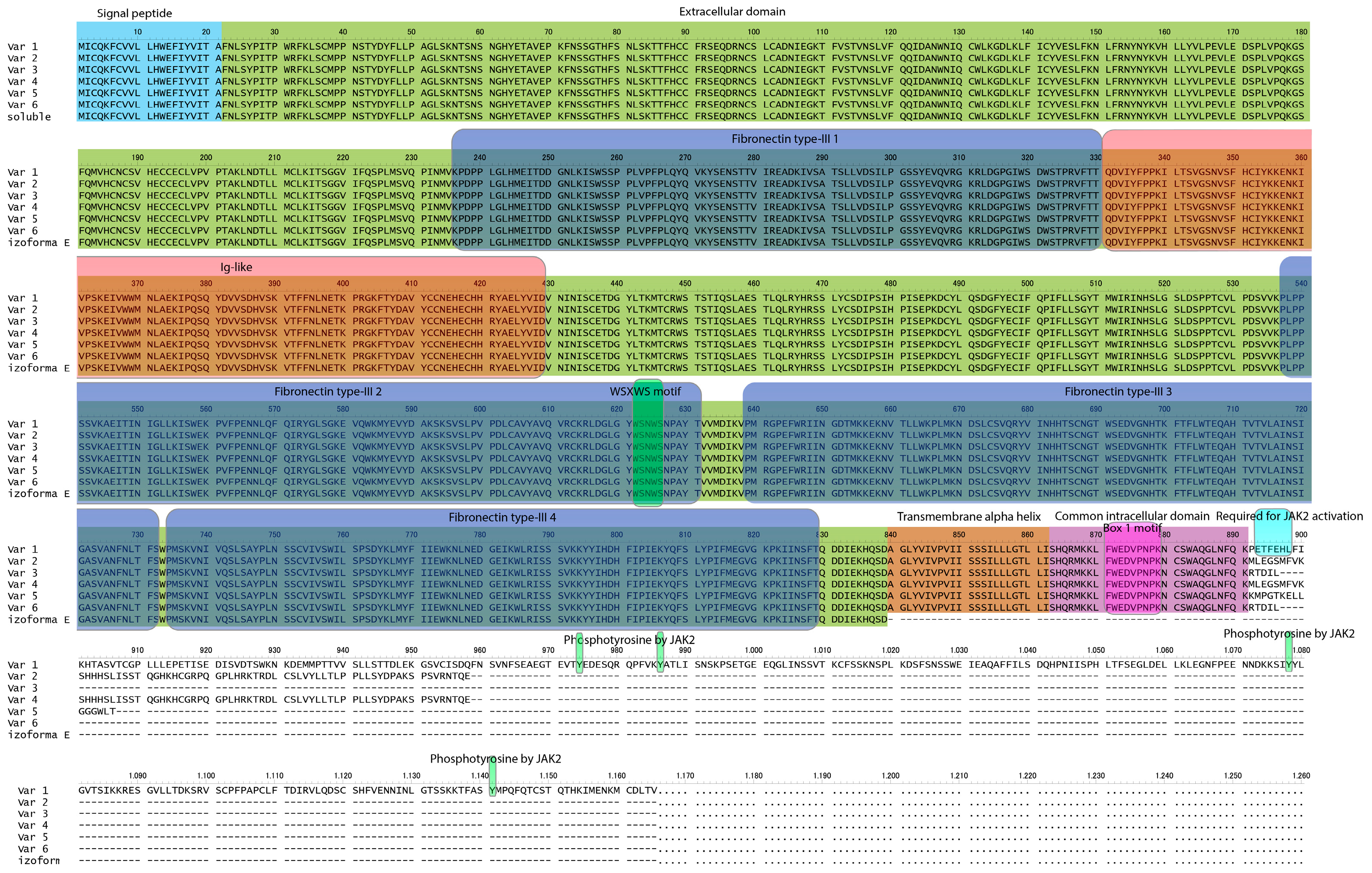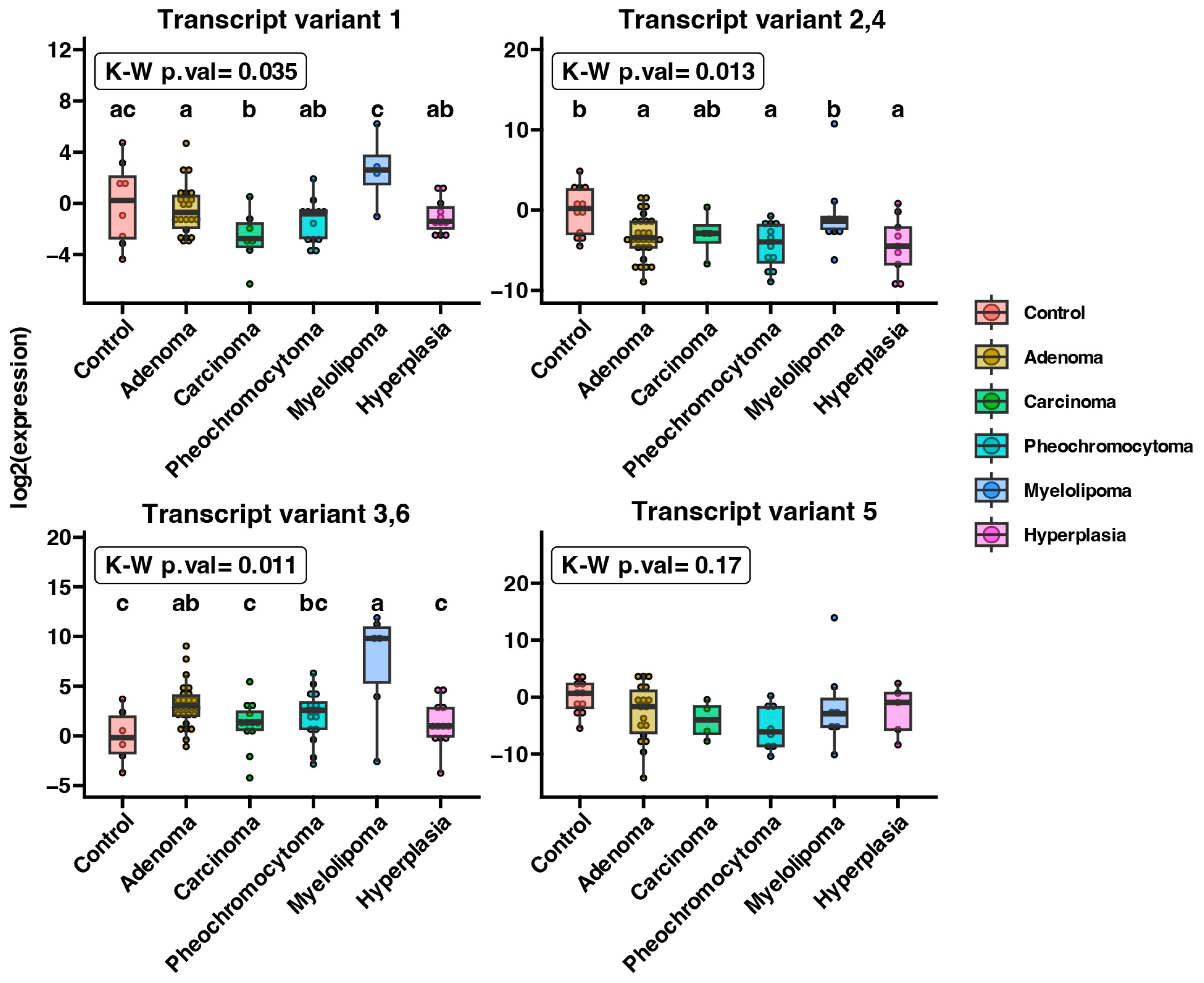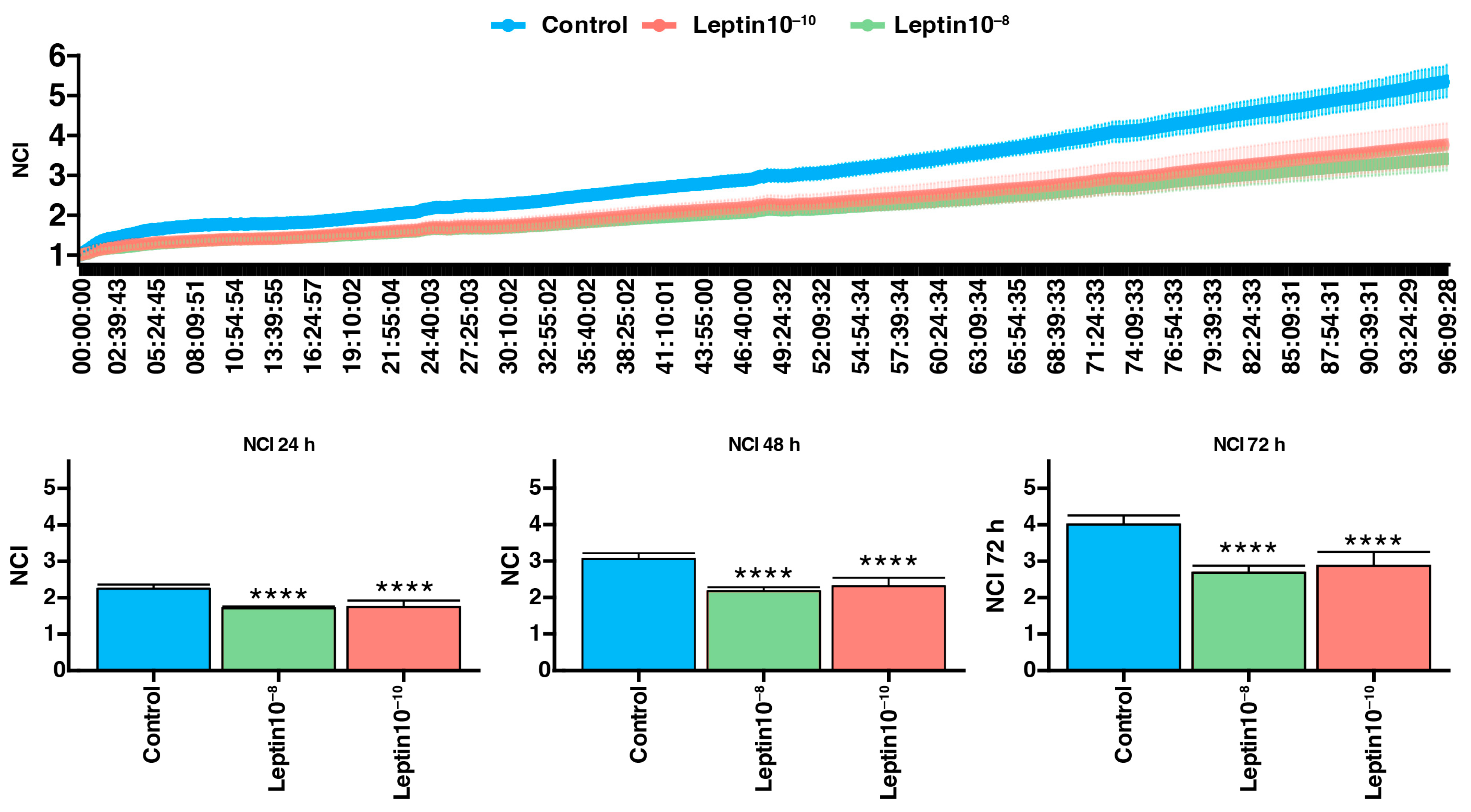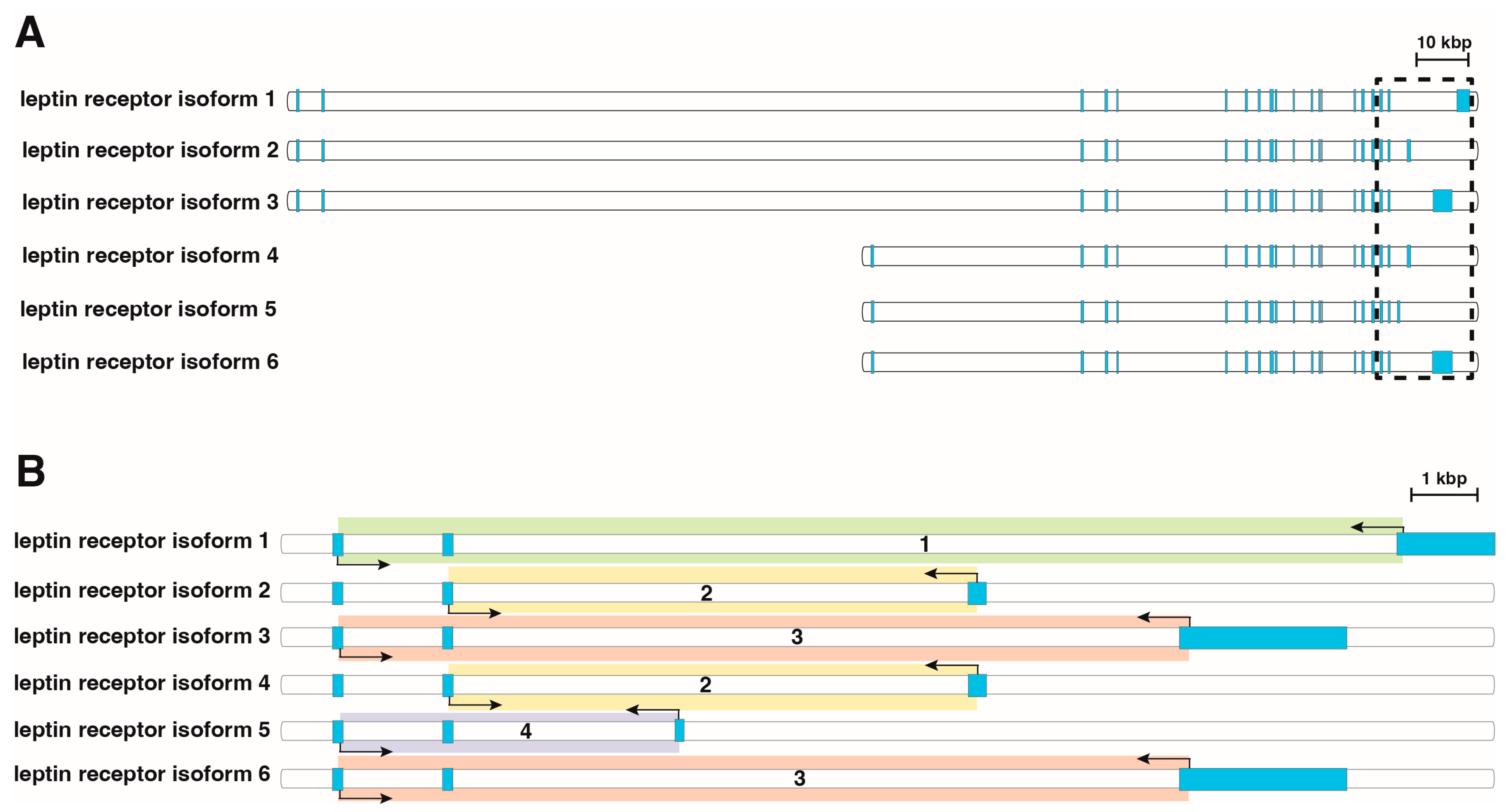Role of Different Variants of Leptin Receptor in Human Adrenal Tumor Types
Abstract
:1. Introduction
2. Results
2.1. Leptin Receptor Isoforms Are Expressed in All Types of Adrenal Lesions and Are Significantly Downregulated in Adrenocortical Carcinoma
2.2. Expression of LepR3&LepR6 mRNA Is Correlated with Overall Survival, Whereas Expression of LepR5 Is Negatively Correlated with Overall Survival
2.3. Expression of LepR2&LepR4 and LepR5 Is Negatively Correlated with Morning Serum Cortisol Concentration
2.4. Effect of Leptin on Proliferative Human Adrenocortical Cell Line
3. Discussion
4. Materials and Methods
4.1. Study Cohort and Strategy
4.2. RNA Isolation
4.3. Reverse Transcription (RT)
4.4. QPCR
4.5. Adrenocortical Carcinoma Cell Line and Treatment
4.6. Cell Proliferation by RTC
4.7. Statistical Analysis
5. Conclusions
Author Contributions
Funding
Institutional Review Board Statement
Informed Consent Statement
Data Availability Statement
Conflicts of Interest
References
- Zhang, Y.; Proenca, R.; Maffei, M.; Barone, M.; Leopold, L.; Friedman, J.M. Positional cloning of the mouse obese gene and its human homologue. Nature 1994, 372, 425–432. [Google Scholar] [CrossRef] [PubMed]
- Myers, M.G. Leptin receptor signaling and the regulation of mammalian physiology. Recent Prog. Horm. Res. 2004, 59, 287–304. [Google Scholar] [CrossRef] [PubMed]
- Cohen, B.; Novick, D.; Rubinstein, M. Modulation of insulin activities by leptin. Science 1996, 274, 1185–1188. [Google Scholar] [CrossRef] [PubMed]
- Gale, S.M.; Castracane, V.D.; Mantzoros, C.S. Energy homeostasis, obesity and eating disorders: Recent advances in endocrinology. J. Nutr. 2004, 134, 295–298. [Google Scholar] [CrossRef] [PubMed]
- Klok, M.D.; Jakobsdottir, S.; Drent, M.L. The role of leptin and ghrelin in the regulation of food intake and body weight in humans: A review. Obes. Rev. 2007, 8, 21–34. [Google Scholar] [CrossRef]
- Yang, C.; DeMars, K.M.; Candelario-Jalil, E. Age-Dependent Decrease in Adropin is Associated with Reduced Levels of Endothelial Nitric Oxide Synthase and Increased Oxidative Stress in the Rat Brain. Aging Dis. 2018, 9, 322–330. [Google Scholar] [CrossRef] [PubMed]
- Wada, N. Subchapter 48A-Leptin. In Handbook of Hormones, 2nd ed.; Ando, H., Ukena, K., Nagata, S., Eds.; Academic Press: San Diego, CA, USA, 2021; pp. 573–575. Available online: https://www.sciencedirect.com/science/article/pii/B9780128206492001467 (accessed on 17 January 2024).
- Korner, J.; Leibel, R.L. To Eat or Not to Eat—How the Gut Talks to the Brain. N. Engl. J. Med. 2003, 349, 926–928. [Google Scholar] [CrossRef] [PubMed]
- Malendowicz, L.K.; Rucinski, M.; Belloni, A.S.; Ziolkowska, A.; Nussdorfer, G.G. Leptin and the regulation of the hypothalamic-pituitary-adrenal axis. Int. Rev. Cytol. 2007, 263, 63–102. [Google Scholar] [PubMed]
- Giordano, R.; Picu, A.; Broglio, F.; Bonelli, L.; Baldi, M.; Berardelli, R.; Ghigo, E.; Arvat, E. Ghrelin, hypothalamus-pituitary-adrenal (HPA) axis and Cushing’s syndrome. Pituitary 2004, 7, 243–248. [Google Scholar] [CrossRef]
- Komarowska, H.; Jaskula, M.; Stangierski, A.; Wasko, R.; Sowinski, J.; Ruchala, M. Influence of ghrelin on energy balance and endocrine physiology. Neuro Enocrinology Lett. 2012, 33, 749–756. [Google Scholar]
- Bocian-Jastrzębska, A.; Malczewska-Herman, A.; Kos-Kudła, B. Role of Leptin and Adiponectin in Carcinogenesis. Cancers 2023, 15, 4250. [Google Scholar] [CrossRef] [PubMed]
- Tartaglia, L.A.; Dembski, M.; Weng, X.; Deng, N.; Culpepper, J.; Devos, R.; Richards, G.J.; Campfield, L.A.; Clark, F.T.; Deeds, J.; et al. Identification expression cloning of a leptin receptor, OB-R. Cell 1995, 83, 1263–1271. [Google Scholar] [CrossRef]
- Wada, N.; Hirako, S.; Takenoya, F.; Kageyama, H.; Okabe, M.; Shioda, S. Leptin and its receptors. J. Chem. Neuroanat. 2014, 61–62, 191–199. [Google Scholar] [CrossRef] [PubMed]
- Lee, G.-H.; Proenca, R.; Montez, J.M.; Carroll, K.M.; Darvishzadeh, J.G.; Lee, J.I.; Friedman, J.M. Abnormal splicing of the leptin receptor in diabetic mice. Nature 1996, 379, 632–635. [Google Scholar] [CrossRef] [PubMed]
- Wang, M.Y.; Zhou, Y.T.; Newgard, C.B.; Unger, R.H. A novel leptin receptor isoform in rat. FEBS Lett. 1996, 392, 87–90. [Google Scholar] [CrossRef] [PubMed]
- Maamra, M.; Bidlingmaier, M.; Postel-Vinay, M.C.; Wu, Z.; Strasburger, C.J.; Ross, R.J. Generation of human soluble leptin receptor by proteolytic cleavage of membrane-anchored receptors. Endocrinology 2001, 142, 4389–4393. [Google Scholar] [CrossRef] [PubMed]
- VanSaun, M.N. Molecular Pathways: Adiponectin and Leptin Signaling in Cancer. Clin. Cancer Res. 2013, 19, 1926–1932. [Google Scholar] [CrossRef]
- Zhang, J.; Scarpace, P.J. The soluble leptin receptor neutralizes leptin-mediated STAT3 signalling and anorexic responses in vivo. Br. J. Pharmacol. 2009, 158, 475–482. [Google Scholar] [CrossRef] [PubMed]
- Nyasani, E.; Munir, I.; Perez, M.; Payne, K.; Khan, S. Linking obesity-induced leptin-signaling pathways to common endocrine-related cancers in women. Endocrine 2019, 63, 3–17. [Google Scholar] [CrossRef]
- Chou, S.H.; Tseleni-Balafouta, S.; Moon, H.-S.; Chamberland, J.P.; Liu, X.; Kavantzas, N.; Mantzoros, C.S. Adiponectin receptor expression in human malignant tissues. Horm. Cancer 2010, 1, 136–145. [Google Scholar] [CrossRef]
- Mitsiades, N.; Pazaitou-Panayiotou, K.; Aronis, K.N.; Moon, H.S.; Chamberland, J.P.; Liu, X.; Diakopoulos, K.N.; Kyttaris, V.; Panagiotou, V.; Mylvaganam, G.; et al. Circulating adiponectin is inversely associated with risk of thyroid cancer: In vivo and in vitro studies. J. Clin. Endocrinol. Metab. 2011, 96, E2023–E2028. [Google Scholar] [CrossRef]
- Komarowska, H.; Rucinski, M.; Tyczewska, M.; Sawicka-Gutaj, N.; Szyszka, M.; Hernik, A.; Klimont, A.; Milecka, P.; Migasiuk, L.; Biczysko, M.; et al. Ghrelin as a potential molecular marker of adrenal carcinogenesis: In vivo and in vitro evidence. Clin. Endocrinol. 2018, 89, 36–45. [Google Scholar] [CrossRef] [PubMed]
- Sawicka-Gutaj, N.; Komarowska, H.; Gruszczyński, D.; Derwich, A.; Klimont, A.; Ruchała, M. Serum Visfatin/NAMPT as a Potential Risk Predictor for Malignancy of Adrenal Tumors. J. Clin. Med. 2022, 11, 5563. [Google Scholar] [CrossRef] [PubMed]
- Socol, C.T.; Chira, A.; Martinez-Sanchez, M.A.; Nuñez-Sanchez, M.A.; Maerescu, C.M.; Mierlita, D.; Rusu, A.V.; Ruiz-Alcaraz, A.J.; Trif, M.; Ramos-Molina, B. Leptin Signaling in Obesity and Colorectal Cancer. Int. J. Mol. Sci. 2022, 23, 4713. [Google Scholar] [CrossRef]
- Akinci, M.; Kosova, F.; Cetin, B.; Aslan, S.; Ari, Z.; Cetin, A. Leptin levels in thyroid cancer. Asian J. Surg. 2009, 32, 216–223. [Google Scholar] [CrossRef] [PubMed]
- Hedayati, M.; Yaghmaei, P.; Pooyamanesh, Z.; Zarif Yeganeh, M.; Hoghooghi Rad, L. Leptin: A correlated Peptide to papillary thyroid carcinoma? J. Thyroid. Res. 2011, 2011, 832163. [Google Scholar] [CrossRef]
- Rehem, R.A.; Elwafa, W.A.; Elwafa, R.A.; Abdel-Aziz, T.E. Study of serum leptin in well-differentiated thyroid carcinoma: Correlation with patient and tumor characteristics. World J. Surg. 2014, 38, 2621–2627. [Google Scholar] [CrossRef]
- Szyszka, M.; Tyczewska, M.; Milecka, P.; Jopek, K.; Celichowski, P.; Malendowicz, L.K.; Rucinski, M. Effects of leptin on leptin receptor isoform expression and proliferative activity in human normal prostate and prostate cancer cell lines. Oncol. Rep. 2018, 39, 182–192. [Google Scholar] [CrossRef]
- Lin, T.C.; Hsiao, M. Leptin and Cancer: Updated Functional Roles in Carcinogenesis, Therapeutic Niches, and Developments. Int. J. Mol. Sci. 2021, 22, 2870. [Google Scholar] [CrossRef]
- Kokoszka, J.; Rzepka, E.; Ulatowska-Białas, M.; Richter, P.; Hubalewska-Dydejczyk, A. Difficulties in the diagnosis and treatment of ruptured pheochromocytoma. Endokrynol. Pol. 2023, 74, 211–212. [Google Scholar] [CrossRef]
- Olakowski, M.; Ciosek, J. Giant pseudocyst of the retroperitoneal space mimicking a lesion arising from the left adrenal gland. Endokrynol. Pol. 2022, 73, 790–791. [Google Scholar] [CrossRef] [PubMed]
- Sherlock, M.; Scarsbrook, A.; Abbas, A.; Fraser, S.; Limumpornpetch, P.; Dineen, R.; Stewart, P.M. Adrenal Incidentaloma. Endocr. Rev. 2020, 41, 775–820. [Google Scholar] [CrossRef] [PubMed]
- Farrugia, F.; Martikos, G.; Tzanetis, P.; Charalampopoulos, A.; Misiakos, E.; Zavras, N.; Sotiropoulos, D. Pheochromocytoma, diagnosis and treatment: Review of the literature. Endocr. Regul. 2017, 51, 168–181. [Google Scholar] [CrossRef] [PubMed]
- Kiseljak-Vassiliades, K.; Bancos, I.; Hamrahian, A.; Habra, M.A.; Vaidya, A.; Levine, A.C.; Else, T. American Association of Clinical Endocrinology Disease State Clinical Review on the Evaluation and Management of Adrenocortical Carcinoma in an Adult: A Practical Approach. Endocr. Pract. 2020, 26, 1366–1383. [Google Scholar] [CrossRef] [PubMed]
- Audenet, F.; Méjean, A.; Chartier-Kastler, E.; Rouprêt, M. Adrenal tumours are more predominant in females regardless of their histological subtype: A review. World J. Urol. 2013, 31, 1037–1043. [Google Scholar] [CrossRef] [PubMed]
- Paragliola, R.M.; Corsello, A.; Locantore, P.; Papi, G.; Pontecorvi, A.; Corsello, S.M. Medical Approaches in Adrenocortical Carcinoma. Biomedicines 2020, 8, 551. [Google Scholar] [CrossRef] [PubMed]
- Erickson, L.A. Challenges in surgical pathology of adrenocortical tumours. Histopathology 2018, 72, 82–96. [Google Scholar] [CrossRef]
- Remnant, L.; Kochanova, N.Y.; Reid, C.; Cisneros-Soberanis, F.; Earnshaw, W.C. The intrinsically disorderly story of Ki-67. Open Biol. 2021, 11, 210120. [Google Scholar] [CrossRef]
- Papathomas, T.G.; Pucci, E.; Giordano, T.J.; Lu, H.; Duregon, E.; Volante, M.; Papotti, M.; Lloyd, R.V.; Tischler, A.S.; van Nederveen, F.H.; et al. An International Ki67 Reproducibility Study in Adrenal Cortical Carcinoma. Am. J. Surg. Pathol. 2016, 40, 569–576. [Google Scholar] [CrossRef]
- Babinska, A.; Kaszubowski, M.; Kmieć, P.; Sworczak, K. Adipokine and cytokine levels in patients with adrenocortical cancer, subclinical Cushing’s syndrome and healthy controls. Steroids 2018, 140, 39–44. [Google Scholar] [CrossRef]
- Stelcer, E.; Milecka, P.; Komarowska, H.; Jopek, K.; Tyczewska, M.; Szyszka, M.; Lesniczak, M.; Suchorska, W.; Bekova, K.; Szczepaniak, B.; et al. Adropin Stimulates Proliferation and Inhibits Adrenocortical Steroidogenesis in the Human Adrenal Carcinoma (HAC15) Cell Line. Front. Endocrinol. 2020, 11, 561370. [Google Scholar] [CrossRef] [PubMed]
- Komarowska, H.; Ruciński, M.; Fichna, M.; Bromińska, B.; Iżycki, D.; Czarnywojtek, A.; Ruchała, M. Changes in total and acylated ghrelin levels during mitotane treatment in patients with adrenocortical carcinoma. Pol. Arch. Intern. Med. 2019, 129, 469–475. [Google Scholar] [PubMed]
- Paschke, L.; Zemleduch, T.; Rucinski, M.; Ziolkowska, A.; Szyszka, M.; Malendowicz, L.K. Adiponectin and adiponectin receptor system in the rat adrenal gland: Ontogenetic and physiologic regulation, and its involvement in regulating adrenocortical growth and steroidogenesis. Peptides 2010, 31, 1715–1724. [Google Scholar] [CrossRef] [PubMed]
- Komarowska, H.; Bromińska, B.; Janicka-Jedyńska, M.; Ruchała, M. Adrenal Incidentaloma: Nothing Is Ever as It Seems. Am. J. Med. 2020, 133, 1048–1050. [Google Scholar] [CrossRef]
- Alrehaili, A.A.; Gharib, A.F.; Bakhuraysah, M.M.; Alharthi, A.; Alsalmi, O.; Alsaeedi, F.A.; Alhakami, R.A.; Alasmari, K.A.; Mohammed, N.; Elsawy, W.H. Serum Pro-Inflammatory Cytokines and Leptin as Potential Biomarkers for Treatment Response and Toxicity in Locally Advanced Squamous Cell Carcinoma of the Head and Neck. Diseases 2024, 12, 55. [Google Scholar] [CrossRef] [PubMed]
- Glasow, A.; Bornstein, S.R.; Chrousos, G.P.; Brown, J.W.; Scherbaum, W.A. Detection of Ob-receptor in human adrenal neoplasms and effect of leptin on adrenal cell proliferation. Horm. Metab. Res. 1999, 31, 247–251. [Google Scholar] [CrossRef] [PubMed]
- Ahima, R.S.; Prabakaran, D.; Mantzoros, C.; Qu, D.; Lowell, B.; Maratos-Flier, E.; Flier, J.S. Role of leptin in the neuroendocrine response to fasting. Nature 1996, 382, 250–252. [Google Scholar] [CrossRef] [PubMed]
- Wilson, M.E.; Fisher, J.; Brown, J. Chronic subcutaneous leptin infusion diminishes the responsiveness of the hypothalamic-pituitary-adrenal (HPA) axis in female rhesus monkeys. Physiol. Behav. 2005, 84, 449–458. [Google Scholar] [CrossRef]
- Zhou, Y.; Rui, L. Leptin signaling and leptin resistance. Front. Med. 2013, 7, 207–222. [Google Scholar] [CrossRef]
- Guo, S.; Gonzalez-Perez, R.R. Notch, IL-1 and leptin crosstalk outcome (NILCO) is critical for leptin-induced proliferation, migration and VEGF/VEGFR-2 expression in breast cancer. PLoS ONE 2011, 6, e21467. [Google Scholar] [CrossRef]
- Harbuzariu, A.; Gonzalez-Perez, R.R. Leptin-Notch axis impairs 5-fluorouracil effects on pancreatic cancer. Oncotarget 2018, 9, 18239–18253. [Google Scholar] [CrossRef] [PubMed]
- Weichhaus, M.; Broom, J.; Wahle, K.; Bermano, G. Leptin inhibits proliferation of breast cancer cells at supraphysiological concentrations by inhibiting mitogen-activated protein kinase signaling. Oncol. Lett. 2014, 8, 374–378. [Google Scholar] [CrossRef] [PubMed]
- Celano, M.; Maggisano, V.; Lepore, S.M.; Sponziello, M.; Pecce, V.; Verrienti, A.; Durante, C.; Maranghi, M.; Lucia, P.; Bulotta, S.; et al. Expression of Leptin Receptor and Effects of Leptin on Papillary Thyroid Carcinoma Cells. Int. J. Endocrinol. 2019, 2019, 5031696. [Google Scholar] [CrossRef] [PubMed]
- Liu, H.; Wu, Y.; Qiao, F.; Gong, X. Effect of leptin on cytotrophoblast proliferation and invasion. J. Huazhong Univ. Sci. Technol. Med. Sci. 2009, 29, 631–636. [Google Scholar] [CrossRef] [PubMed]
- Tai, Y.; Shang, J. Wnt/β-catenin signaling pathway in the tumor progression of adrenocortical carcinoma. Front. Endocrinol. 2024, 14, 1260701. [Google Scholar] [CrossRef] [PubMed]
- Tamburello, M.; Altieri, B.; Sbiera, I.; Sigala, S.; Berruti, A.; Fassnacht, M.; Sbiera, S. FGF/FGFR signaling in adrenocortical development and tumorigenesis: Novel potential therapeutic targets in adrenocortical carcinoma. Endocrine 2022, 77, 411–418. [Google Scholar] [CrossRef]
- Thompson, K.J.; Lau, K.N.; Johnson, S.; Martinie, J.B.; Iannitti, D.A.; McKillop, I.H.; Sindram, D. Leptin inhibits hepatocellular carcinoma proliferation via p38-MAPK-dependent signalling. HPB 2011, 13, 225–233. [Google Scholar] [CrossRef] [PubMed]
- Fassnacht, M.; Tsagarakis, S.; Terzolo, M.; Tabarin, A.; Sahdev, A.; Newell-Price, J.; Pelsma, I.; Marina, L.; Lorenz, K.; Bancos, I.; et al. European Society of Endocrinology clinical practice guidelines on the management of adrenal incidentalomas, in collaboration with the European Network for the Study of Adrenal Tumors. Eur. J. Endocrinol. 2023, 189, G1–G42. [Google Scholar] [CrossRef]
- Sawicka-Gutaj, N.; Gruszczyński, D.; Guzik, P.; Mostowska, A.; Walkowiak, J. Publication ethics of human studies in the light of the Declaration of Helsinki—A mini-review. J. Med. Sci. 2022, 91, e700. [Google Scholar] [CrossRef]
- Wickham, H. Data Analysis. In ggplot2: Elegant Graphics for Data Analysis; Wickham, H., Ed.; Springer International Publishing: Cham, Switzerland, 2016; pp. 189–201. [Google Scholar] [CrossRef]
- Guzik, P.; Więckowska, B. Data distribution analysis—A preliminary approach to quantitative data in biomedical research. J. Med. Sci. 2023, 92, e869. [Google Scholar] [CrossRef]






| Variable | ACC, N = 19 | Adenoma, N = 35 | Hyperplasia, N = 14 | Myelolipoma, N = 10 | Pheochromocytoma, N = 18 |
|---|---|---|---|---|---|
| Tumor diameter (mm) | 115 (74, 155) | 29 (16, 43) | 38 (24, 57) | 65 (55, 77) | 50 (36, 60) |
| Ki67% | 20 (10, 30) | NA (NA, NA) | NA (NA, NA) | NA (NA, NA) | NA (NA, NA) |
| Overall Survival (months) | 18 (7, 61) | NA (NA, NA) | NA (NA, NA) | NA (NA, NA) | NA (NA, NA) |
| FPG (mg/dL) | 94 (86, 113) | 96 (89, 107) | 135 (94, 202) | 91 (86, 96) | 107 (98, 130) |
| TSH (µU/L) | 1.56 (1.06, 1.83) | 1.35 (0.74, 2.71) | 1.17 (0.98, 1.34) | 2.01 (1.80, 2.02) | 1.67 (1.66, 1.75) |
| Ft4 (pmol/L) | 16.50 (13.22, 17.30) | 16.30 (14.60, 18.30) | 16.06 (14.93, 16.37) | 20.54 (16.93, 21.25) | 15.79 (15.69, 16.24) |
| Total cholesterol (mg/dL) | 178 (143, 220) | 212 (170, 241) | 175 (164, 216) | 152 (139, 161) | 219 (177, 248) |
| HDL (mg/dL) | 47 (37, 62) | 56 (50, 73) | 134 (86, 318) | 58 (50, 109) | 88 (57, 103) |
| LDL (mg/dL) | 108 (73, 128) | 108 (83, 143) | 61 (47, 71) | 64 (43, 90) | 94 (61, 145) |
| TAG (mg/dL) | 132 (93, 159) | 140 (103, 187) | 106 (83, 185) | 107 (93, 107) | 120 (103, 154) |
| Morning cortisol (nmol/L) | 427 (340, 633) | 500 (428, 600) | 719 (444, 782) | 367 (237, 587) | 482 (402, 630) |
| Evening cortisol (nml/L) | 315 (150, 534) | 160 (91, 296) | 397 (171, 753) | 193 (146, 391) | 138 (69, 177) |
| Post-DST (nmol/L) | 452 (225, 611) | 420 (125, 639) | 162 (162, 162) | NA (NA, NA) | 1314 (1314, 1314) |
| ACTH (pg/mL) | 26 (2, 39) | 14 (6, 31) | 10 (6, 21) | 36 (22, 122) | 48 (30, 79) |
| DHEAS (µg/dL) | 164 (52, 534) | 70 (31, 118) | 108 (58, 125) | 100 (43, 155) | 125 (83, 278) |
| Testosterone (nmol/L) | 4 (1, 12) | 1 (0, 4) | 4 (2, 6) | 17 (14, 18) | 17 (9, 19) |
| SHBG (nmol/L) | 36 (28, 68) | 50 (40, 65) | 100 (100, 100) | NA (NA, NA) | 49 (33, 76) |
| Androstendione (ng/mL) | 2.89 (1.31, 8.63) | 1.29 (0.43, 1.44) | 3.83 (3.79, 3.86) | 0.75 (0.75, 0.75) | 3.50 (3.04, 4.07) |
| 17-OHP (ng/mL) | 2.33 (0.72, 3.27) | 1.07 (0.76, 1.61) | 0.82 (0.82, 0.82) | 20.00 (20.00, 20.00) | 5.92 (5.92, 5.92) |
| Na (mmol/L) | 141.00 (139.00, 143.50) | 141.00 (140.00, 143.00) | 142.00 (140.50, 142.75) | 141.00 (141.00, 141.00) | 141.00 (140.00, 142.00) |
| K (mmol/L) | 4.37 (4.02, 4.63) | 4.37 (4.06, 4.58) | 4.20 (3.58, 4.43) | 4.56 (4.33, 4.82) | 4.57 (4.21, 4.69) |
| Primers Number | Transcript Variant | Primer | Primer Sequence (5′-3′) | Position | PCR Product Size (bp) |
|---|---|---|---|---|---|
| 1 | Transcript variant 1 of leptin receptor | S | CAGAGTGATGCAGGTTTATATG | 2694–2715 | 208 |
| A | CTGATGCTGTATGCTTGATAA | 2901–2881 | |||
| 2 | Transcript variant 2, 4 of leptin receptor | S | GCCAGTAATTATTTCCTCTTCC | 2723–2744 | 198 |
| A | CCCTGGGTACTTGAGATTAG | 2920–2901 | |||
| 3 | Transcript variant 3, 6 of leptin receptor | S | TATGTAATTGTGCCAGTAA | 2712–2730 | 200 |
| A | ACATTGGGTTCATCTGTAGTG | 2911–2891 | |||
| 4 | Transcript variant 5 of leptin receptor | S | TCCCCATTGAGAAGTACCAGT | 2555–2575 | 300 |
| A | CACCCAGTAGTTCCTTTGTGC | 2854–2834 | |||
| - | HPRT | S | GCCATCACATTGTAGCCCTC | 343–362 | 172 |
| A | ACTTTTATGTCCCCTGTTGACT | 514–493 | |||
| - | Beta -2-Microglobulin | S | ATGATGCTGCTTACATGTCTC | 261–280 | 170 |
| A | AAAAGTGGAGCATTCAGACT | 410–430 |
Disclaimer/Publisher’s Note: The statements, opinions and data contained in all publications are solely those of the individual author(s) and contributor(s) and not of MDPI and/or the editor(s). MDPI and/or the editor(s) disclaim responsibility for any injury to people or property resulting from any ideas, methods, instructions or products referred to in the content. |
© 2024 by the authors. Licensee MDPI, Basel, Switzerland. This article is an open access article distributed under the terms and conditions of the Creative Commons Attribution (CC BY) license (https://creativecommons.org/licenses/by/4.0/).
Share and Cite
Klimont, A.; Ruciński, M.; Sawicka-Gutaj, N.; Szyszka, M.; Blatkiewicz, M.; Wierzbicki, T.; Karczewski, M.; Janicka-Jedyńska, M.; Ruchała, M.; Komarowska, H. Role of Different Variants of Leptin Receptor in Human Adrenal Tumor Types. Int. J. Mol. Sci. 2024, 25, 8682. https://doi.org/10.3390/ijms25168682
Klimont A, Ruciński M, Sawicka-Gutaj N, Szyszka M, Blatkiewicz M, Wierzbicki T, Karczewski M, Janicka-Jedyńska M, Ruchała M, Komarowska H. Role of Different Variants of Leptin Receptor in Human Adrenal Tumor Types. International Journal of Molecular Sciences. 2024; 25(16):8682. https://doi.org/10.3390/ijms25168682
Chicago/Turabian StyleKlimont, Anna, Marcin Ruciński, Nadia Sawicka-Gutaj, Marta Szyszka, Małgorzata Blatkiewicz, Tomasz Wierzbicki, Marek Karczewski, Małgorzata Janicka-Jedyńska, Marek Ruchała, and Hanna Komarowska. 2024. "Role of Different Variants of Leptin Receptor in Human Adrenal Tumor Types" International Journal of Molecular Sciences 25, no. 16: 8682. https://doi.org/10.3390/ijms25168682






